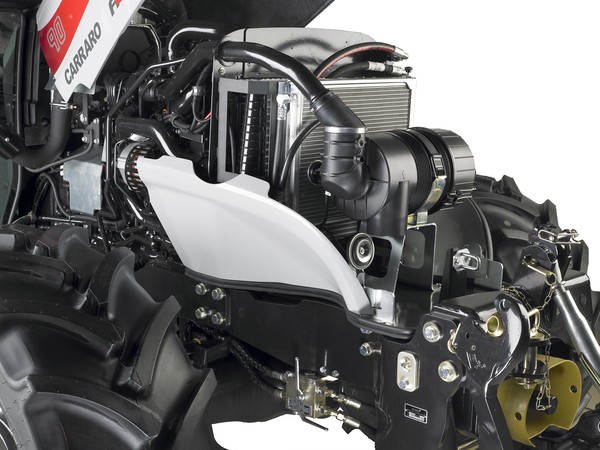
Agricultural engine air filters
These components are essential to the best functioning of the diesel engine. To achieve optimum combustion, about 20 parts of air per one of diesel are generally required in modern agricultural engines. Therefore, the air filter must be thoroughly and adequately serviced
One of the essential requirements for the proper functioning and durability of an internal combustion engine is undoubtedly the air's best cleaning introduced into the combustion chamber. This is of particular importance in the agricultural sector since the concentration of dust in the environment can reach high values (up to 500 mg/m3 of air) in the case of tillage or haymaking, for instance, with peaks as high as 20,000 mg/m3 in case of combine harvesters.
According to the rotation speed, the amount of combustion air entering a diesel engine depends on the displacement, the air density, and the number of times the cylinder is filled. In modern agricultural diesel engines, about 20 parts of air are generally required for optimum combustion. Therefore, the combustion air filter must be carefully and thoroughly serviced; cleaning (or possible replacement) must be carried out promptly at the deadlines set by the manufacturer, following the instructions provided in the user manual. A clogged filter can reduce engine performance, increase fuel consumption, and, consequently, pollutant emissions. A deteriorated filter can also cause premature engine wear, with possible cylinder scratches and reduced piston ring sealing.
Dry filters
With its high filtration efficiency even in very dusty working environments (up to 99.8-99.9% of particles up to 1 ìm in diameter), the dry filter, also known as "cartridge filter", is the most widespread type in the agricultural sector. It usually consists of a cylindrical plastic container, often placed in front of the radiator, containing two coaxial filter cartridges.
The container, openable through spring unlocking sliders, is equipped with air inlet and outlet ducts and, on one end, with a sleeve with a rubber basal valve that allows the expulsion of dust end. The outer cartridge (called "main") acts as a primary filter element. At the same time, the inner one (also called "safety") prevents the entry of solid particles that may have escaped the action of the main cartridge into the intake manifold.
To ensure a large filtration surface area and allow a regular and uniform air suction, both cartridges are made of pleated cellulose or polyester fabric sheets, treated with synthetic resins (phenolic or alkylic). The paper's reliefs are often intentionally flattened on the fold profile to increase the capacity of accumulation of dust. In some cases, the cellulose can be covered - on one side only - with a layer of nano-fibers; this makes the main cartridge able to retain dust even smaller than 1 ìm. Cartridges are internally and externally reinforced by a wire mesh framework and are equipped with soft polyurethane seals to ensure excellent adhesion and tightness to the filter container sides.
There is a membrane sensor at the outlet duct to the motor feed system in many applications, with continuous monitoring of the suction vacuum level. In the filter clogging event beyond a predefined threshold, a warning light on the machine dashboard warns the operator about the need for timely cleaning, regardless of the intervals prescribed for routine maintenance of the vehicle.
The outer cartridge can be cleaned - usually every 1000-1200 working hours or at least once a year - using compressed air (at a maximum pressure of 5-6 bar), directing the jet from the inside to the outside of the cartridge and following the pleated paper lines. However, the leading manufacturers advise against this practice, as the compressed air jet could tear the material (even with micro-breaks, not visible to the naked eye), reducing the filtering effect. It is therefore suggested, as an alternative, to replace the filter every 600 working hours. At any rate, the main cartridge must be replaced either after a maximum of six cleaning operations (or before, if damaged), or when the interval prescribed by the manufacturer has expired. Conversely, the internal cartridge should never be cleaned, but only replaced after the main cartridge has been cleaned (or replaced) three times.
In the most evolved models, the cleaning of the inlet air can be simplified using pre-filters, which can be placed outside or inside the engine compartment, or through devices creating a depression on the exhaust pipe of the engine, such as to intercept and eliminate the coarsest particles, which would tend to clog the filter in a short time. In the first event, a small rotor inside the filter rotates at high speed, which drives the impurities towards the specific exhaust slots in the pre-filter. These impurities are then stored in a particular container to be periodically emptied.
Oil-bath filters
This type has been introduced for a longer time, but it is now not very widespread on modern agricultural machinery because of the slightly lower filtering capacity of dry filters. Today it can be found on tractors produced until the 80s of the last century, and almost exclusively on small machinery, such as motor cultivators, motor hoes, and motor mowers.
The filtering element is a cartridge made of metal mesh or, more often, of synthetic material (nylon), installed in a filter-holder container and dipped in a well-defined quantity of oil, of the same type used for the engine lubrication.
The inlet airflow is bubbled through the oil, which, thanks to the cartridge's mesh, traps the impurities. As expected, like dry filters, even in oil bath filters, the correct maintenance is of paramount importance and involves periodic cleaning of the mesh cartridge. Generally, this is carried out by washing with diesel oil and complete drying with compressed air, together with removing the oil in the container, with the subsequent elimination of impurities deposited on the bottom.
The container must then be filled exactly to the level specified since, if it is too high, the engine sucks in oil together with the combustion air, resulting in the risk of episodes of "over revving" and excessive smoke; if, on the other hand, the level is too low, not perfectly filtered air may reach the combustion chamber.
Oil-bath filters with centrifugal pre-filters (cyclone)
When an oil bath filter is used, for engines mounted on machinery designed to work in dusty environments, the additional installation of a centrifugal pre-filter (the so-called "cyclone") removes the more massive dust particles from the incoming air, is recommended.
It basically consists of a tank containing oil placed at the top end of the filter itself, which uses as a filter element a hollow cartridge in the center, and consists of a thick metal or nylon mesh, also in contact with oil in the basal portion of the filter itself.
The air enters the pre-filter and gurgles in the oil, passing through the filter mesh and releasing the dust that is trapped in the liquid. On average, the pre-filter can retain about 60% of the dust, while the remaining part is intercepted by the filter oil, with the overall effectiveness of about 99%.
The maintenance of these filters is very simple and there is no need to replace the cartridge: it is necessary to periodically empty the pre-filter tray and, of course, replace the oil every 4-500 working hours.
Unlike dry filters, and similarly to simple oil-bath filters, this filter type cannot be adopted for supercharged engines because of the risk of oil suction inside the turbocharger.








